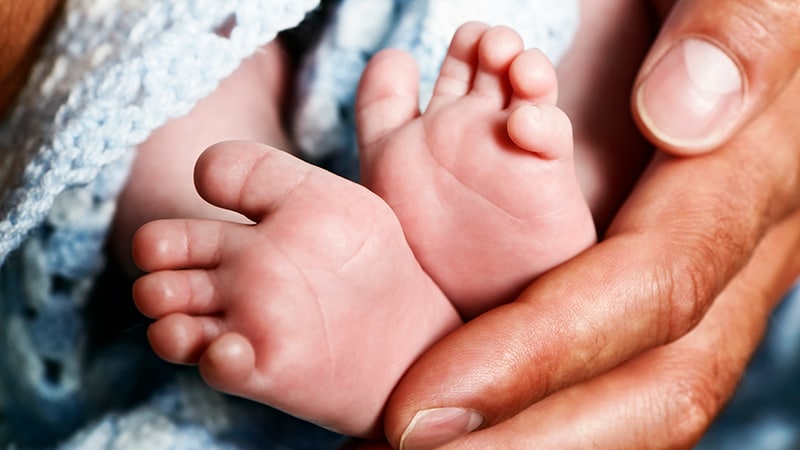
The link between major birth defects and an increased risk for childhood cancer persists into adulthood, although the risk decreases with time.
The new findings come from a Nordic database review published recently in The BMJ.
The review authors linked national birth and cancer registries from Finland, Norway, Sweden, and Denmark. The study included 62,295 patients with cancer who ranged in age from the time of birth to 46 years; 724,542 control persons were matched by age and country of birth.
The team confirmed the well-established link between major birth defects and childhood cancer, but they also found that the odds of cancer were 21% higher in adults aged 20 to 46 years who had structural birth defects and 50% higher in adults with chromosomal anomalies compared with adults who did not have birth defects.
In addition to chromosomal anomalies, adult cancer was associated with skeletal dysplasia (odds ratio [OR], 3.54), nervous system defects (OR, 1.76), genital organs defects (OR, 1.43), and congenital heart defects (OR 1.28). There was no association with adult cancer and eye, limb, abdominal wall, digestive system, respiratory system, or urinary tract birth defects or orofacial clefts.
Cancer risk was substantially lower for adults than for children and adolescents with birth defects, except that genital organ defects were associated with a higher risk for adulthood cancer. This higher risk was driven in part by testicular cancer, which becomes more common with the testosterone surge at puberty and peaks at age 30 to 35 years.
The study team, led by doctoral student Dagrun Slettebø Daltveit, University of Bergen, Norway, writes that "the most important implication of our results is to provide further rationale for additional studies on the molecular mechanisms involved in the developmental disruptions underlying both birth defects and cancer."
However, there are few clinical implications from this study, say experts in an accompanying editorial.
"In general, the rarity of cancer in adults under 50 argues against screening except for those with markedly elevated risk due to an inherited predisposition to cancer.... Neither does a reason exist to suggest that cancer treatment should be modified in people with birth defects," write Logan Spector, PhD, professor of pediatrics, University of Minnesota, Minneapolis, Minnesota, and pediatric cardiologist Lazaros Kochilas, MD, Emory University, Atlanta, Georgia.
"Apart from the low incidence of cancer, many children and adults with repaired defects receive no regular specialist follow-up care; many such people (and their clinicians) may not even realize that they had a birth defect. Oncologists might inquire about a history of birth defects, but ascertainment is likely to be poor," they add.
Details of the Findings
Overall, 3.5% of case patients and 2.2% of control persons had a major birth defect. Across all ages, the odds of cancer were 74% greater among people with major birth defects. The odds were 54% greater with nonchromosomal birth defects and more than five times greater with chromosomal anomalies, especially Down syndrome.
The odds of having cancer were highest among children with birth defects up to the age of 14 years, followed by adolescents, then adults. The odds fell from childhood to adulthood for both structural and chromosomal birth defects.
Congenital heart, limb, and genital defects were the most common.
The largest malignancy groups were lymphoid and hematopoietic cancers, genitourinary cancers, and central nervous system tumors.
Leukemia was the most common malignancy among people with chromosomal anomalies. Structural defects increased the risk for cancer in several organ systems. Many of the structural defects were associated with later cancer in the same organ system or anatomic location.
The risk for cancer increased with the number of birth defects. The median age at the time of cancer diagnosis was 23 years.
Adjustments for in vitro fertilization, maternal age, and maternal smoking did not change the study results substantially, but information on some potential confounders was missing, including parental income and education. The study included only birth defects diagnosed in the hospital.
The study was funded by the Norwegian Cancer Society. The investigators and editorialists have disclosed no relevant financial relationships.
BMJ. Published online December 2, 2020. Full text, Editorial
M. Alexander Otto is a physician assistant and award-winning medical journalist who has previously worked for several major news outlets, including McClatchy and Bloomberg BNA. He is a former MIT Knight Science Journalism fellow. Email: aotto@mdedge.com.
For more from Medscape Oncology, join us on Twitter and Facebook.
"between" - Google News
December 15, 2020 at 09:46PM
https://ift.tt/34dDTxY
Link Between Major Birth Defects and Increased Risk for Cancer - Medscape
"between" - Google News
https://ift.tt/2WkNqP8
https://ift.tt/2WkjZfX
Bagikan Berita Ini















0 Response to "Link Between Major Birth Defects and Increased Risk for Cancer - Medscape"
Post a Comment